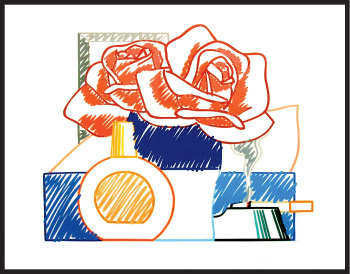 For an artist who detested the use of the word “Pop” to describe his work, Tom Wesselmann (1931-2004) nevertheless became inextricably linked to that modern-art movement.
For an artist who detested the use of the word “Pop” to describe his work, Tom Wesselmann (1931-2004) nevertheless became inextricably linked to that modern-art movement.
“Next to Warhol, he’s probably the greatest American Pop artist,” says Lois Pincus Cohn, owner of Birmingham’s Artspace II Gallery. “Both of them were heavily influenced by advertising,” she says. “They made you look at what had been perceived as commercialism in a new way — as art.”
The Cincinnati-born artist’s 1991 screen print, Scribble Version of Still Life 28, above, is included in the gallery’s current American Masters exhibition, which also includes art by modern masters Robert Motherwell, Alex Katz, Andy Warhol, and Benny Andrews.
In his collages, Wesselmann often used found objects. Similarly, this Still Life includes roses, a perfume bottle, picture frame, and a lit cigarette. “He chooses rather trivial things, then he makes them very large and reduces them to stereotypes,” Cohn says.
“To me, the items portrayed here are evocative of 1930s elegance. You can almost hear Bobby Short playing the piano. But it’s sort of a spoof,” she says.
Cigarettes played a strong role in the artist’s Smokers series, which became almost as famous as his Great American Nude series. Wesselmann’s palette was bold and vibrant. “He liked strong, mostly primary colors,” Cohn says.
In his later works, Wesselmann became more influenced by Matisse, but he never lost the ironic, impish outlook he developed as a young cartoonist in the ’50s.
Artspace II Gallery, 303 E. Maple, Birmingham; 248-258-1540, artspace2.com.
|
|
|






